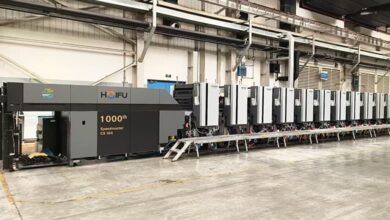Heidelberg Gets Out Of Its Comfort Zone
Heidelberg name is synonymous with commercial and offset printing. The company has always been a diehard offset manufacturer. The company dips its toes in digital printing waters once in a while but you always have a feeling that its DNA is not compatible with digital printing. So when recently the company announced is extending its digital and software portfolio and pooling activities in this sector in the digital division all sorts of speculations are being made. This time it seems that Heidelberg is dead serious about expanding in a meaningful way in digital printing. Heidelberg is planning to enhance it’s existing digital printing range and launch new products.
Company’s joint inkjet projects with Gallus and Fujifilm is a clear indication of Heidelberg’s new approach to printing industry. Heidelberg’s new strategy dubbed as Synerjetix will be based on bringing to market new digital solutions. Synerjetix” stands for the joint development of industrialized ink jet production systems and according to Heidelberg it enables printers to offer high-end, creative applications with reliable machinery that meets proven Heidelberg quality standards. “We see inkjet technology as a driver for new applications inside and outside our industry. That’s why we are combining our know-how with that of our partners, and creating well-integrated systems. First and foremost, we want to work with our partners to improve the quality of inkjet applications and thereby increase our customers’ confidence in this technology,” explains Stephan Plenz, Member of the Management Board responsible for Heidelberg Equipment.
The first technology presentation is planned for this fall, when a label printing press that combines flexographic and inkjet printing will be unveiled as a cost-effective solution for producing short runs and customized labels. The new development comprises a digital inline printing system based on inkjet technology from Fujifilm, which is integrated into a label printing press from Gallus. “Today, just five percent of all labels are printed digitally. However, the demands for customized, cost-effective, and versatile printing solutions in this market segment are growing. We are working with our partners Fujifilm and Gallus to present a solution that will meet these demands perfectly,” says Jason Oliver, Head of the Digital business unit at Heidelberg. In parallel with this development, Heidelberg and Fujifilm have initiated a joint project to develop new highly productive inkjet-based digital printing systems for use in commercial and packaging printing markets. Although digital printing based on electrophotography has come of age, industrialized ink jet systems for high quality, high productivity sheetfed applications are only now beginning to emerge.
“4D” printing
Part of Heidelberg’s new strategy is to bring a new digital inkjet machine which enables customized printing on three-dimensional objects. The machine is called Jetmaster Dimension. According to Heidelberg more and more end users are looking for personalized design options when shopping for mass-produced items such as sporting goods, footwear, furniture, and cars. High-quality printing with logos, text, and other graphic elements is usually their first choice. What’s more, the technology can also be used to print large-scale advertisements on airplanes, trucks, buses, and trams – an application that currently requires labor intensive and costly film-based solutions.
Multi-channel publishing
At the end of last year, in a move to gain a foothold in the growing multi-channel publishing segment, Heidelberg acquired a stake in Siegen-based German software manufacturer Neo7even. Heidelberg aims to use Neo7even software to open up new business options for print shops, enabling them to offer their customers media-neutral publishing services, for example in print and online, on a wider scale in the future. The new portfolio ties in closely with Prinect and is being gradually integrated into this.
Oliver sums it all up: “Ultimately, all our digital activities have one common goal: We want to ensure that our customers have a successful and profitable future and continue to secure a sustainable business for Heidelberg”
Making profit after all these years
Recent announcement on Heidelberg’s new approach to the world of graphic arts have been followed by some good news about Heidelberg’s financial results. Following five years of losses, Heidelberg has started making a profit again. According to preliminary calculations, the net profit for financial year 2013/2014 (April 1, 2013 to March 31, 2014) was around € 4 million (previous year: € -117 million). Heidelberg claims that these figures means the company has achieved its key target for the financial year just closed. It seems that Heidelberg finally is on a path to profitability and if that means getting out of your comfort zone then be it.





